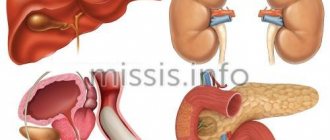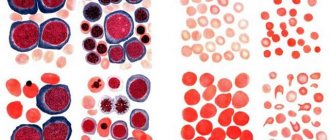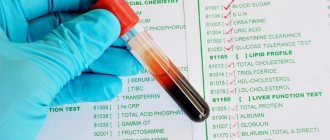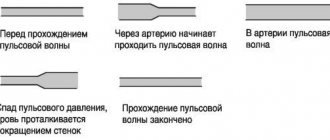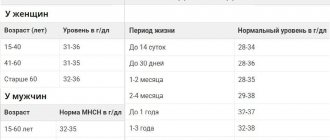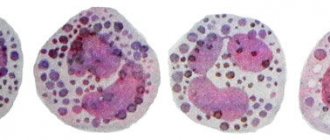general characteristics
Creatinine is the end product of creatine breakdown, which plays an important role in the energy metabolism of muscle and other tissues. Its formation directly depends on the state of muscle mass. Creatinine is excreted by the kidneys (it is excreted only by the glomeruli and, unlike urea, is not reabsorbed in the renal tubules), therefore a decrease in creatinine excretion in the urine and an increase in creatinine in the blood is observed in patients with kidney damage. Daily urinary excretion of creatinine depends on gender, age, and total muscle mass. In combination with serum creatinine, it is used to calculate creatinine clearance and assess renal function.
Detailed description of the study
Creatinine is the end product of the metabolism of nitrogen-containing compounds in the body. Nitrogen metabolism is the reaction of the formation and breakdown of nitrogenous compounds, which include proteins, vitamins, hormones, and nucleic acids. It is part of energy metabolism.
Creatine is a precursor to creatinine. It is formed from amino acids - arginine, glycine, methionine - in the kidneys and liver. In the muscles, under the influence of enzymes, it is converted into creatine phosphate, which serves as a source of energy for movement. After detachment of the phosphorus group, creatinine is formed, which is excreted in the urine.
A healthy person excretes a certain amount of creatinine per day and this figure is constant. Its value depends on the person’s muscle mass, on average it is 10-25 mg in women, and 15-30 mg in men.
Creatinine is excreted by the kidneys and is practically not reabsorbed, that is, it is not absorbed in the tubules and does not enter back into the blood. Therefore, creatinine clearance—the time it takes for creatinine to be cleared from the body—is used to determine the glomerular filtration rate. The value is calculated by measuring the level of creatinine in urine and blood over a certain time and estimating the volume of urine per day.
If kidney function is impaired, the excretion of creatinine in the urine decreases. A decrease in glomerular filtration is observed in renal failure, glomerulonephritis, etc. Causes of renal failure: decrease in circulating blood (during bleeding), damage to kidney vessels, urolithiasis, autoimmune processes, toxic damage from drugs. Clinically, renal failure is manifested by the occurrence of severe thirst, edema, nausea, vomiting, and weakness.
A decrease in the amount of creatinine in the urine also occurs with a decrease in muscle mass due to various diseases: myositis, paralysis, paresis, muscular dystrophy. The latter include Duchenne muscular dystrophy, a genetic disease associated with impaired protein formation for muscle contraction. It manifests itself in childhood and progresses rapidly until complete immobilization occurs.
An increase in the amount of creatinine in the blood and urine occurs with increased glomerular filtration, for example, with diabetes, pregnancy, and infections. Also, an increase in level occurs with injuries, burns, hypothyroidism, acromegaly. Acromegaly is a neuroendocrine disease characterized by disproportionate growth of bones and soft tissues.
Determining the amount of creatinine in daily urine, in contrast to one-time urine, allows you to most fully assess its clearance, promptly identify disorders in the kidneys and prescribe treatment.
Patient preparation rules
urine
Notes:
Any portion of urine, regardless of the time of day, is collected after toileting the external genitalia.
daily urine Notes:
Perform the first morning urination in the toilet.
Collect all further daily urine, including the morning portion of the next day, into a container (important - the volume of the container must be sufficient for the expected amount of urine per day). During the entire collection period, keep biological material in a cool place, protected from light. After the collection is completed, determine the daily volume of collected urine, mix, pour 30-40 ml into a standard urine container and deliver to the ML DILA department within 2 hours after collecting the last portion. morning urine Notes:
The morning portion of urine is collected after toileting the external genitalia.
You can add this study to your cart on this page
Creatinine in Biochemical Analysis (CREA)
Creatinine is the result of the metabolism of complex energy-carrying molecules. These molecules are formed in the liver and are carried to all cells, delivering the energy necessary for life. Energy is released after the rupture of special chemical bonds, resulting in the formation of breakdown products that return to the blood. One part of them is reused in the synthesis of new energy carriers, and the other part is utilized by the excretory system as compounds foreign to the body. Among them is creatinine. It is always present in the blood, which indicates normal metabolism.
Energy metabolism is most active in muscle tissue (especially during physical activity), nerve cells (during mental stress) and in the gastrointestinal tract (after eating). The indicator is different for opposite sexes, since it is believed that a man has more developed muscles, harder work, and more active metabolic processes.
Norm:
- For men – 74-110 µmol/l;
- For women – 44-80;
- Children under 14 years old – 27-62;
- Children under 12 months – 18-35.
If excretion is not impaired, all “extra” creatinine is successfully utilized in the urine. Otherwise, when the kidneys cannot cope with the load and are unable to filter it out, the concentration increases. Pathology of the urinary system
is the most common cause of increased CREA.
However, excess of the norm also occurs when its formation is enhanced, despite the intact excretory function in the case of:
- Muscle damage (injuries, burns, inflammation);
- Intoxication;
- Metabolic disorders (thyrotoxicosis, diabetes mellitus);
- Massive blood loss;
- Autoimmune processes;
- Hepato-biliary diseases.
The decrease is somewhat less common and is typical for situations not associated with any pathology:
- Reducing protein in the diet (diet, fasting);
- Dystrophy, atrophy, cachexia;
- The first three months of pregnancy.
A change in normal values is not always a sign of the presence of a disease. For example, this indicator may increase after heavy physical or intense mental work, a rich meat diet, or drinking large amounts of alcohol. To exclude such false positive results:
- Determined strictly on an empty stomach;
- Reduce meat consumption the day before;
- Avoid alcohol and intense work during the day.
Creatinine level testing is mandatory
if any symptoms associated with kidney dysfunction (swelling, discomfort in the lower back, changes in urine), liver (unpleasant sensations in the right hypochondrium, bitterness in the mouth), unmotivated muscle pain occur. If you have any doubts, you should consult a doctor who can clearly determine the indications for the CREA test.
Interpretation:
- Often called “hyperfiltration”, it is detected in the following conditions: physical activity, acromegaly, gigantism, diabetes mellitus (before clinical manifestations of diabetic nephropathy), infections, hypothyroidism, meat food, increased cardiac output, pregnancy, burns, carbon monoxide poisoning, increased metabolism, anemia.
- Indicates a decrease in glomerular filtration rate, detected in the following conditions: hyperthyroidism, anemia, paralysis, muscular dystrophy, diseases with a decrease in muscle mass (for example, neurogenic atrophy, polymyositis, etc.), inflammatory and metabolic diseases.
Sample result (PDF)
Creatinine
Creatinine is a product of the non-enzymatic breakdown of creatine and creatine phosphate, which is formed in muscles. It is excreted from the body by the kidneys.
Research method
Kinetic method (Jaffe method).
Units
μmol/L (micromoles per liter).
What biomaterial can be used for research?
Venous, capillary blood.
How to properly prepare for research?
- Do not eat for 12 hours before the test.
- 30 minutes before the analysis, eliminate physical and emotional stress.
- Do not smoke for 30 minutes before donating blood.
General information about the study
Creatinine is a residual product produced in muscles when a substance called creatine is broken down. Creatine is part of a cycle that provides the body with energy to contract muscles. After 7 seconds of intense physical activity, creatine phosphate is converted to creatine, which then turns into creatinine, which is filtered in the kidneys and excreted in the urine. Creatine and creatinine are stably produced by our body in constant quantities. Almost all creatinine is excreted by the kidneys, so its concentration in the blood is a good indicator of kidney function. The amount of creatinine produced depends on total body weight and, in particular, muscle mass. Therefore, for example, creatinine levels in men will be significantly higher than in women and children.
What is the research used for?
- To assess renal function.
- To assess the function of major organs and systems.
- To assess renal dysfunction and the effectiveness of its treatment.
- If the level of creatinine in the blood and urine is known, the creatinine clearance (Rehberg test) can be calculated - this test shows how effectively the kidneys filter small molecules such as creatinine from the blood.
- To calculate the glomerular filtration rate to confirm kidney damage.
What do the results mean?
Reference values (creatinine norm):
| Age, gender | Reference values |
| 13 – 15 years | 50 – 77 µmol/l |
| > 15 years old, male | 62 - 106 µmol/l |
| > 15 years old, female | 44 - 80 µmol/l |
Causes of increased creatinine levels
- Acute and chronic renal failure.
- Insufficiency of the cardiovascular system.
- Massive destruction of muscle tissue.
- Burns.
- Acromegaly.
- Gigantism.
- Hyperthyroidism.
- Dehydration.
- Excessive physical activity.
- Excessive consumption of meat products.
- Radiation sickness.
- Obstruction of the urinary tract.
- Taking nephrotoxic drugs.
- Glomerulonephritis.
- Bacterial kidney infection (pyelonephritis).
- Necrosis of the tubular epithelium (acute tubular necrosis).
- Prostate diseases causing obstruction of the urinary system.
Reasons for decreased creatinine levels
- Starvation.
- Overhydration.
- Amyotrophy.
Important Notes
The creatinine content is reduced in pregnant women by almost half due to an increase in blood volume (hypervolemia), increased blood flow in the kidneys and, accordingly, an increasing degree of filtration; all this leads to an increase in creatinine clearance (excretion in urine).
In older people, creatinine formation normally decreases; this must be taken into account when determining the severity of their kidney disease.
Urine collection instructions
The nurse will give you the necessary supplies:
- plastic container for collecting urine; manual urinal (issued to men);
- a cup for collecting urine (issued to women);
- if you are receiving hospital treatment, you may be given a bedpan;
Immediately before the start of daily urine collection
You must begin counting the urine collection period with an empty bladder. Immediately before the start of the daily collection, urinate in the toilet and flush. Then write down the date and time. This moment will be the beginning of the urine collection period. The collection will end in 24 hours.
Collection start date: ___________________ Collection start time: _________________
During the 24-hour urine collection period
- Collect all urine. Urinate only into a urine bag, urine collection cup, or bedpan. To use a urine collection cup, place it under the toilet seat and urinate into it.
- If you are in hospital, seek help if necessary.
Why do they take a creatinine test before a CT scan?
Examination is recommended for patients before CT with contrast. Contrast involves that before scanning, a special iodine-containing drug is injected into the patient's brachial vein using an injector. It is distributed throughout the circulatory system, “staining” soft tissues and vessel walls on scans (CT angiography), thus increasing the information content of the study.
Contrast is not always performed, but only in cases where it is necessary to examine blood vessels or check organs and soft tissues for damage and tumors, especially oncological ones. The effectiveness of CT with contrast in this case is based on the fact that in places where malignant tumors are localized, the blood supply differs from normal: it is more or, conversely, less intense. Malignant neoplasms appear to be the site of abnormal (pathological) accumulation of the contrast agent, and are more clearly visualized on CT scans.
After the examination, the iodine-containing drug is excreted from the body through urine naturally. Our center uses Omnipaque contrast from the group of the safest non-ionic drugs.
The contrast is excreted from the body by the kidneys within 1-2 days. A laboratory biochemical blood test for creatinine (“Rehberg test” or “serum creatinine”) is necessary in order to exclude kidney pathologies, or more precisely, impaired excretory function.
The blood test showed elevated creatinine. What does it mean?
My biochemical blood test showed elevated creatinine. Please tell me what this indicator is?
Irina Stepanova, Orsha.
Creatinine is a chemical compound in the human body produced from amino acids.
It is found in animal products such as beef and fish and is also sold as a dietary supplement. Creatinine improves strength, muscle mass and athletic performance. At the beginning of the chain of transformations is creatine. This component carries out a long journey through the body, starting in the kidneys and continuing in the liver. After this, the substance is sent to the muscles, where creatine phosphate is created from creatine. The resulting component enters the muscles, giving them energy to contract. After its use, the residues enter the bloodstream and are excreted in the urine. This energy turnover occurs in the body constantly; the amount of substance in the circulatory system remains the same, provided the body is in a normal state. Professional athletes and those whose work involves heavy physical activity, as well as people on a diet or taking certain antibacterial drugs, experience a slight increase in creatinine in the blood. These are physiological reasons, they do not manifest themselves clinically and do not require special correction. A pathologically elevated level of creatinine is usually accompanied by the appearance of symptoms such as nagging pain in the lumbar region, unmotivated weakness, fatigue, drowsiness, and impaired consciousness. This symptomatology may be associated both with an increase in the supply of creatinine from the muscles, and with a violation of its excretion.
A significant increase in creatinine levels occurs in acute and chronic renal failure. Along with kidney problems, high levels are observed in severe heart failure, thyroid dysfunction, and also in certain malignant tumors that cause muscle tissue breakdown. The same effect is caused by injuries with muscle damage, burns, long-term compression syndrome, and radiation sickness.
This indicator completely depends on gender and age, as well as on kidney performance, accumulated muscle mass and food consumption preferences.
If the level of creatinine in the blood is slightly higher than normal, and the person who took the test has an athletic build and is not a person who eats only plant foods, then there is no reason to worry.
If these are elderly people, then the level of creatinine decreases, therefore, the results of the analysis simply state age-related changes in the body.
Please note that creatinine levels differ between men and women.
This can be explained by the fact that the stronger half is endowed with greater muscle mass. A slight deviation of creatinine from the norm cannot be considered a problem, since a person is in constant energy metabolism and at the next moment the excess energy can be used. But if the level of creatinine is seriously exceeded, it means that for some reason there are problems with the elimination of the substance, which led to the accumulation of creatinine in the blood and a toxic effect on the body. Olga PERESADA, Professor of the Department of Obstetrics and Gynecology of BelMAPO, Doctor of Medical Sciences.


